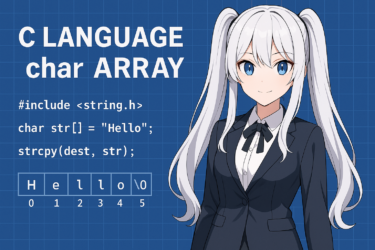1. Basics of void in C Language
In C language, void is a special keyword that indicates the function does not return a value. It is used when a function performs a specific task and does not need to return its result. For example, void is used for functions that output data or perform simple processing. For beginners in C language, understanding this concept is important. Because by using void correctly, the structure and intent of the program become clear, improving the readability and maintainability of the code.
Role of void
voidis a keyword in C language that indicates the function does not return a return value.- By using
voidin the function prototype, it is clearly indicated that the function returns nothing.
2. void What is it?
void is a keyword that indicates the return type of a function. Usually, functions return values of a specific type, but by specifying void, it explicitly indicates that the function returns nothing. Additionally, void is also used to indicate that the function has no arguments. In this case, by using void, it can explicitly indicate that the function takes no arguments.
void Usage
- Functions with no return value: By specifying
voidas the return value, it indicates that the function returns nothing. - Functions with no arguments: If the function takes no arguments, it can be indicated using
void.

3. void When to Use
void functions are used when performing specific processing without needing to use the result in other parts. For example, functions that display messages on the screen or close files. In such cases, using void explicitly indicates that the function does not need to return a value, making the code easier to understand.
void Usage Examples
- Output Function: A function for displaying results, where no return value is needed after display.
- Initialization Function: A function that initializes specific resources, where no return value is needed after initialization.
4. void Function Examples
void Here are some basic examples of functions.
Example 1: Message Display Function
#include
void printMessage() {
printf("Hello, World!n");
}
int main() {
printMessage();
return 0;
}This function printMessage displays the message “Hello, World!”. Since no return value is needed, it is defined as void.
Example 2: Variable Initialization
void initializeArray(int arr[], int size) {
for(int i = 0; i < size; i++) {
arr[i] = 0;
}
}This function initializeArray initializes the array. It only initializes the array, so no return value is needed.

5. The Role of void in Function Prototypes
By using void in the function prototype declaration, it explicitly indicates that the function does not return a value. This improves the readability and ease of understanding of the code.
Example of Prototype Declaration
void displayMessage(void);In this declaration, the displayMessage function takes no arguments and returns no value.
6. void Best Practices
void Best practices when using include using void only when the function does not need to return anything. Also, to improve code readability, strive to clearly indicate the function’s intent by using void.
void Function Design
- Simple Design:
voidfunctions are suitable for executing simple tasks. - Clear Purpose: Clearly define what the function does, and consider explaining in comments why no return value is needed.
7. void Advanced Usage
In more advanced C programming, you can use void* pointers to handle generic data types. void* can point to any data type and is especially useful when managing memory or creating generic functions.
void* Example
void* myFunction() {
// Returns a pointer to any data type
}In this example, you can use void* to return a pointer to any data type. This is helpful when creating highly reusable functions.

8. Summary and Key Points
voidis used to indicate that a function does not return a value.voidmakes the purpose of the function clear and improves the readability of the code.- As an advanced usage, it is possible to handle generic data types using
void*.
9. Related Resources and Further Learning
- “The C Programming Language” by Kernighan and Ritchie
- Online C Language Tutorials
voidand Pointer Usage Detailed Documentation
Through this article, understand the basics to advanced usage of void in the C language, and use it to practice more effective C programming.




